FENTANYL - TRANSDERMAL
PHONETIC PRONUNCIATION: (FEN-ta-nil)
COMMON BRAND NAME(S): Duragesic
GENERIC NAME(S): fentanyl
Uses
USES: This medication is used to help relieve severe ongoing pain (such as due to cancer). Fentanyl belongs to a class of drugs known as opioid (narcotic) analgesics. It works in the brain to change how your body feels and responds to pain. Do not use the patch form of fentanyl to relieve pain that is mild or that will go away in a few days. This medication is not for occasional ("as needed") use.
How to use FENTANYL - TRANSDERMAL
HOW TO USE: See also Warning section. Read the Medication Guide and, if available, the Patient Information Leaflet provided by your pharmacist before you start using this medication and each time you get a refill. Learn how to properly use, store, and discard the patches. If you have any questions, ask your doctor or pharmacist. Use this medication on a regular schedule as directed by your doctor, not as needed for sudden (breakthrough) pain. Before you start using this medication, ask your doctor or pharmacist if you should stop or change how you use your other opioid medication(s). It may take up to 24 hours before you have pain relief from fentanyl patches. Other pain relievers (such as acetaminophen, ibuprofen) may also be prescribed. Ask your doctor or pharmacist about using fentanyl safely with other drugs. Apply this medication to the skin as directed by your doctor. Do not apply on burns, cuts, irritated skin, or skin that has been exposed to radiation (x-ray treatment). Select a dry, non-hairy area on a flat part of your body, such as the chest, sides, back, or upper arms. In young children or in people unable to think clearly (such as due to dementia), apply the patch on the upper back to lessen the chance it might be removed or placed in the mouth. If there is hair on the skin, use scissors to clip the hair as close as possible to the skin. Do not shave hair since this might cause skin irritation. If needed, use water to clean the area. Do not use soap, oils, lotions, or alcohol on the application site. Dry the skin well before applying the patch. The patch is usually changed every 72 hours. To avoid irritation, apply to a different area each time. Be sure to remove the old patch before applying a new patch. The used patch still contains enough fentanyl to cause serious harm, even kill a child or pet, so fold it in half with the sticky sides together and discard properly. Do not let children see you apply a patch, and do not apply the patch where children can see it. Children have found patches that have fallen off or removed patches on sleeping adults and put them in their mouths or on their bodies with fatal results. (See also Warning section). Do not use the patch if it appears to be broken, cut, or damaged. Remove from the sealed pouch, peel off the protective liner, and apply right away to the skin. Press firmly in place with the palm of the hand for 30 seconds, making sure the contact is complete (especially around the edges). If your prescribed dose is for more than one patch, make sure the edges of the patches do not touch or overlap. Wash your hands after applying the patch. If you have problems with the patch not sticking at the application site, you may tape the edges in place with first aid tape. If this problem persists, ask your doctor for advice. If the patch falls off before 72 hours, a new patch may be applied to a different skin site. Be sure to let your doctor know if this happens. If you accidentally touch the sticky layer to your skin or handle a cut or damaged patch, wash the area well with clear water. If the patch comes off and accidentally sticks to the skin of another person, immediately remove the patch, wash the area with water, and get medical help for them right away. Do not use soap, alcohol, or other products to wash the area. The dosage is based on your medical condition and response to treatment. Do not apply more patches than directed, change them more frequently, or use them for a longer time than prescribed. This medication may cause withdrawal reactions, especially if it has been used regularly for a long time or in high doses. In such cases, withdrawal symptoms (such as restlessness, watering eyes, runny nose, nausea, sweating, muscle aches) may occur if you suddenly stop using this medication. To prevent withdrawal reactions, your doctor may reduce your dose gradually. Ask your doctor or pharmacist for more details, and report any withdrawal reactions right away. When this medication is used for a long time, it may not work as well. Talk with your doctor if this medication stops working well. Though it helps many people, this medication may sometimes cause addiction. This risk may be higher if you have a substance use disorder (such as overuse of or addiction to drugs/alcohol). Use this medication exactly as prescribed to lower the risk of addiction. Ask your doctor or pharmacist for more details. Tell your doctor if your pain persists or worsens.
Side Effects
Precautions
Interactions
Overdose
Images
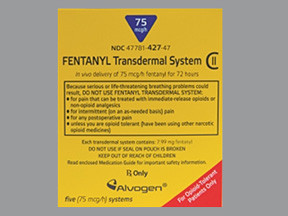
- color
- translucent
- shape
- rectangle
- imprint
- FENTANYL 75mcg/h
Reviews
Faq for FENTANYL - TRANSDERMAL
Fentanyl transdermal is a medication that is administered through a patch attached to the skin. It is a potent opioid painkiller used to manage severe chronic pain that requires around-the-clock treatment.
Fentanyl transdermal works by releasing the medication slowly and continuously through the skin into the bloodstream. It binds to opioid receptors in the brain and spinal cord, reducing the perception of pain.
Fentanyl transdermal is primarily prescribed for patients with chronic pain conditions such as cancer-related pain or severe, long-term pain unresponsive to other treatments.
The patch is usually changed every 72 hours (3 days). However, follow the instructions provided by your healthcare provider and do not change the patch more frequently without consulting them.
Common side effects of Fentanyl transdermal include nausea, constipation, drowsiness, dizziness, itching, and skin irritation at the application site. Serious side effects may include slowed breathing, confusion, fainting, or severe allergic reactions. Contact your doctor immediately if you experience any severe side effects.
Like other opioids, Fentanyl transdermal has a potential for addiction and abuse, especially when used improperly or for a long duration. It should be used strictly as prescribed under the supervision of a healthcare professional.
Some precautions include avoiding alcohol consumption, operating machinery, or driving while under the influence of Fentanyl transdermal. Additionally, inform your doctor about any other medications you are taking, especially other opioids or sedatives, as they can interact with Fentanyl and lead to dangerous side effects.
No, the patch should never be cut, folded, or altered in any way. Doing so may result in an incorrect dosage or release of too much medication, which can be life-threatening.
If the patch accidentally falls off, contact your healthcare provider immediately for further guidance. Do not attempt to reuse the patch or reapply it without medical advice.
Warning
WARNING: Fentanyl has a risk for abuse and addiction, which can lead to overdose and death. Fentanyl may also cause severe, possibly fatal, breathing problems. Do not use transdermal patches unless you have been regularly using moderate to large amounts of opioid pain medication. Otherwise, it may cause overdose (even death). To lower your risk, your doctor should have you use the smallest dose of fentanyl that works, and use it for the shortest possible time. See also How to Use section for more information about addiction. The risk for severe breathing problems is higher when you start this medication and after a dose increase, or if you use the wrong dose/strength. Using this medication with alcohol or other drugs that can cause drowsiness or breathing problems may cause very serious side effects, including death. Be sure you know how to use fentanyl and what other drugs you should avoid using with it. See also Drug Interactions section. Get medical help right away if any of these very serious side effects occur: slow/shallow breathing, unusual lightheadedness, severe drowsiness/dizziness, difficulty waking up. Do not use this medication to relieve mild, short-term, or sudden pain (such as due to headache/migraine, dental/medical procedures), or pain after surgery (including same-day surgery when you do not need to stay in the hospital overnight). This medication is not for occasional ("as needed") use. Since they are not used the same way, different forms of fentanyl (including lozenges, buccal tablets, patches) do not have the same effects at equal strengths and should not be substituted for each other. Tell your doctor or pharmacist of all medications that you use, especially of drugs that can affect how fentanyl works. Do not start, stop, or change the dosage of any medicines you are using without your doctor's approval. Carefully follow the manufacturer's instructions for using fentanyl transdermal patches. The patches are for use on the skin only. Raising your skin/body temperature, using cut or damaged fentanyl patches, or using the patch improperly (such as by chewing it) may cause fatal overdose. Avoid increasing your skin temperature at/near the application site by using products such as heating pads, electric blankets, hot tubs, heat lamps, or tanning lamps. Avoid taking hot baths and sunbathing. However, you may bathe, shower, or swim while wearing the patch as long as you avoid hot water. Before using this medication, women of childbearing age should talk with their doctor(s) about the risks and benefits. Tell your doctor if you are pregnant or if you plan to become pregnant. During pregnancy, this medication should be used only when clearly needed. It may slightly increase the risk of birth defects if used during the first two months of pregnancy. Also, using it for a long time or in high doses near the expected delivery date may harm the unborn baby. To lessen the risk, use the smallest effective dose for the shortest possible time. Babies born to mothers who use this drug for a long time may develop severe (possibly fatal) withdrawal symptoms. Tell the doctor right away if you notice any symptoms in your newborn baby such as crying that doesn't stop, slow/shallow breathing, irritability, shaking, vomiting, diarrhea, poor feeding, or difficulty gaining weight. Keep this medicine in a safe place to prevent theft, misuse, or abuse. This medication is not recommended for use in children younger than 2 years. Some manufacturers recommend that this product should not be used in children younger than 18 years. If someone accidentally swallows this drug, get medical help right away.
Disclaimer
IMPORTANT: HOW TO USE THIS INFORMATION: This is a summary and does NOT have all possible information about this product. This information does not assure that this product is safe, effective, or appropriate for you. This information is not individual medical advice and does not substitute for the advice of your health care professional. Always ask your health care professional for complete information about this product and your specific health needs.
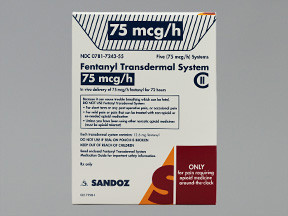

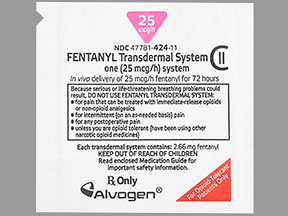


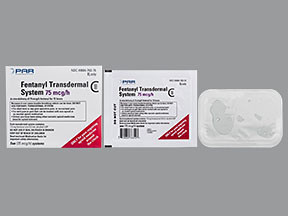
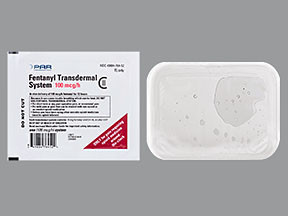
No Reviews Yet